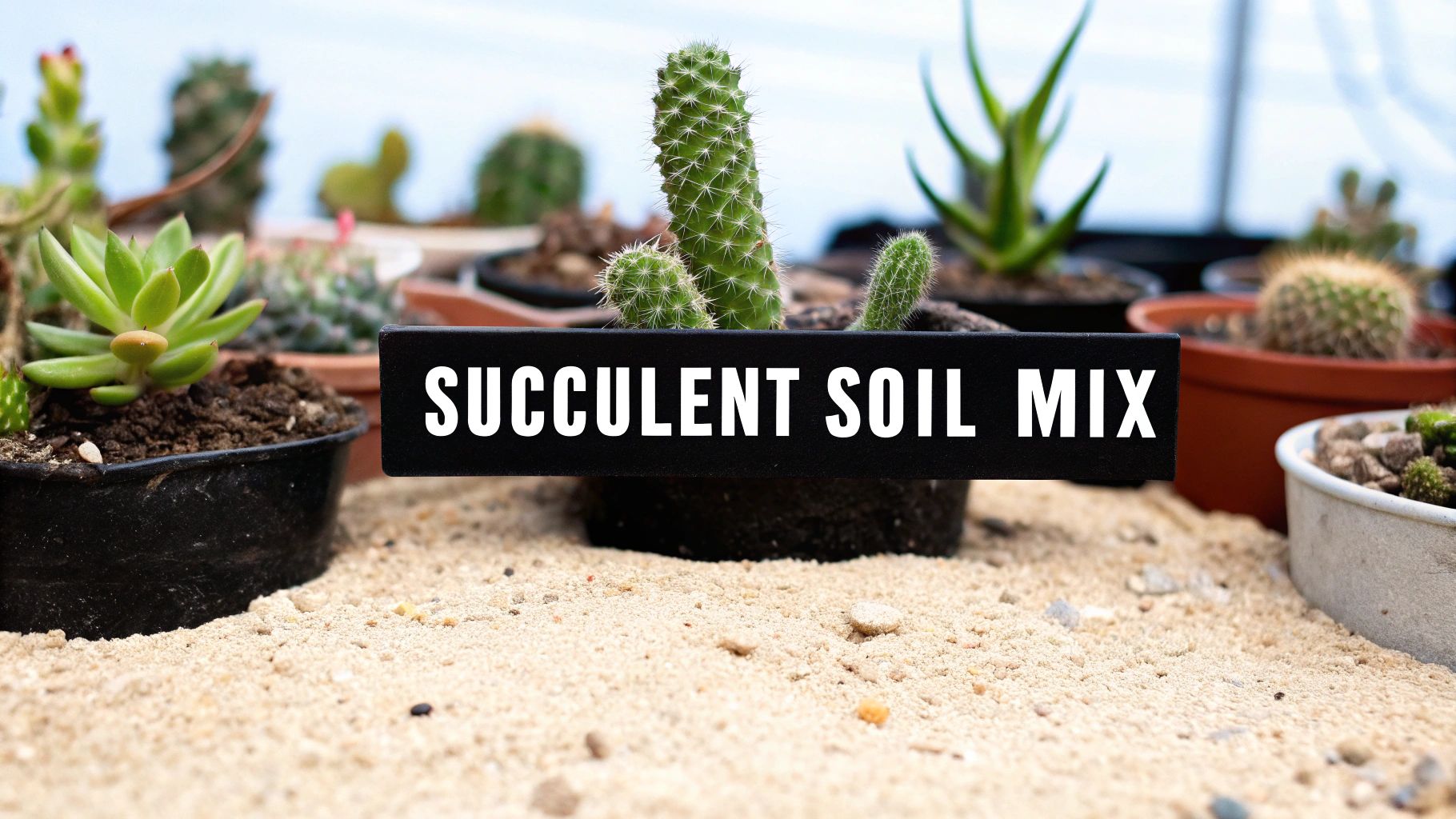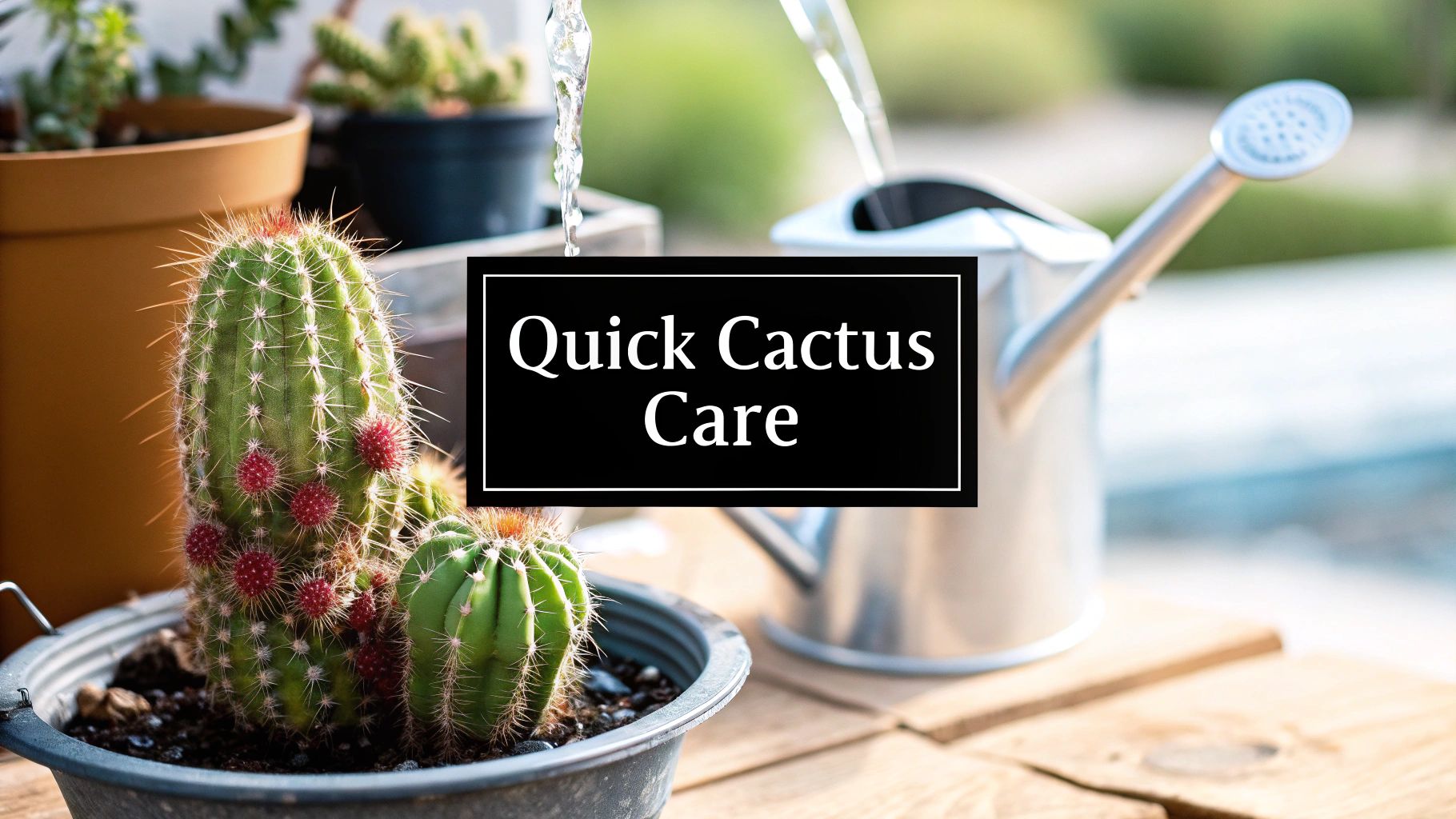Alright, let's talk about the single most important thing for your aloe plant: sunlight. Getting this right is the difference between a sad, droopy succulent and a vibrant, thriving one.
So, what's the magic number? Your aloe is happiest with about six hours of bright, indirect sunlight every day. Think of it this way: your aloe loves a bright party, but it doesn't want to be standing directly under the harsh glare of the spotlight. Too much direct, intense sun will literally scorch its leaves.
What Does "Bright, Indirect Light" Actually Mean?
I get this question all the time. It sounds a bit vague, but it's actually pretty simple to spot once you know what to look for.
Imagine the sun's rays pouring into a room. Direct sunlight is that intense, hot patch on the floor where you can feel the heat. Bright, indirect light is the ample, cheerful glow that fills the rest of the space, just outside of that direct beam. It's bright enough to read a book by without squinting, but it’s not harsh. This is your aloe’s happy place.
The Ideal Spot in Your Home
You're looking for a location that mimics the dappled light your aloe would get in its natural habitat. The perfect spot is often just a few feet away from a window, not right up against the glass where the sun's rays are most concentrated.
Here's what to look for:
- A spot near a south- or west-facing window, but pulled back just enough to be out of the direct sunbeams.
- A room that stays brightly lit for a good portion of the day.
- If your only option is a window with intense sun, just hang a sheer curtain. It’s the perfect filter.
Here’s a great little trick: Look at the shadow your plant casts. If it’s a soft, slightly blurry shadow, the light is perfect. If you see a sharp, dark shadow with crisp edges, the light is too direct and you risk sunburn.
Finding the Right Duration
Once you've found the right kind of light, you need to make sure your plant gets enough of it. Aim for a solid six hours a day. This is the fuel your aloe needs for photosynthesis, which is how it creates the energy to grow and produce that famous gel.
Just a word of caution: aloes don't like sudden, dramatic changes. If you're moving a plant from a dim corner into a much brighter spot, don't just plop it in the sun. This can shock the plant and cause sunburn—those unsightly brown or reddish spots on the leaves. You need to acclimate it slowly over a week or two. For a deeper dive into this, you can learn more about optimal light conditions for succulents. This gradual process is called "hardening off," and it's a crucial step for keeping your plant healthy.
To make things even easier, here's a quick cheat sheet to help you find the best spot for your aloe.
Aloe Sunlight Quick Reference
Use this simple table to quickly assess whether a spot in your home is right for your aloe.
| Light Condition | Optimal Duration | Signs of Trouble |
|---|---|---|
| Bright, Indirect | 6+ hours per day | None! Leaves are green, firm, and growing upright. |
| Direct Sun | Less than 1-2 hours | Leaves turn reddish-brown (sunburn), dry, or crispy. |
| Low Light | Not recommended | Leaves are pale, thin, and "leggy" as they stretch for light. |
This table should give you a good baseline, but always remember to watch your plant. It will tell you everything you need to know about whether it's happy with its current home.
Finding the Perfect Sunlit Spot Indoors
Alright, let's put on our "light detective" hats and scout out the best location in your home for your aloe. The biggest clue to follow is your window direction, as each one serves up a completely different kind of light as the day goes on. The whole game is about matching what your window offers with your aloe's love for bright, indirect sun.
Think of a south-facing window as the beachfront property for most sun-loving plants. It gets the most intense, longest-lasting light of any spot in the house. While that sounds great, parking your aloe right on the windowsill might be a bit much, almost like a day at the beach without sunscreen. Just pull it back a few feet, and you'll give it that perfect balance of brightness without the risk of a nasty sunburn.
An east-facing window, on the other hand, is often the sweet spot. It gets that gentle, direct morning sun—the kind that's not strong enough to do any damage. For the rest of the day, it's bathed in that consistent, bright but indirect light that aloes absolutely adore. It’s pretty much the "set it and forget it" option.
Comparing Window Placements
So, let's quickly run through the pros and cons of each window direction to pinpoint that ideal location for your aloe.
- South-Facing: This is the gold standard for sheer brightness. The trick is to tame that intense midday sun, either with a sheer curtain or by simply setting the plant back from the glass.
- West-Facing: This window delivers a blast of strong, direct afternoon sun. It can get surprisingly hot and intense, so you’ll need to take the same precautions as with a south-facing spot to avoid scorching the leaves.
- East-Facing: This is a fantastic choice. It gives your aloe a gentle wake-up call with direct morning sun and then keeps it happy with bright, indirect light for the rest of the day.
- North-Facing: This spot offers the least amount of light. Honestly, it's generally not enough for an aloe to really thrive, and you'll likely see weak, stretched-out growth as a result.
If you're feeling like your options are a bit limited, figuring out how to increase natural light in your home can be a game-changer, opening up new possibilities for where your aloe can live.

This image really drives home just how critical the right kind of light is for photosynthesis and keeping your plant healthy and vibrant. If you're looking for more detailed placement ideas, our guide on where to put a cactus offers some great tips that are just as useful for your aloe. You can check it out here: https://www.cactusoutlet.com/blogs/blog/where-is-the-best-place-to-put-a-cactus-in-the-house
Reading the Signs of Light Stress In Your Aloe

Your aloe communicates through color and posture—if you learn to read those cues, you’ll catch trouble early. Once you recognize what its leaves are trying to tell you, you can step in and restore its balance.
Like a friend dropped into a scorching desert, an overexposed aloe ramps up its defenses, producing pigments that turn its foliage reddish-brown or orange. That dramatic hue shift is its way of waving a red flag.
Too Much Sun Exposure
When direct sunlight becomes too intense, your aloe literally gets a sunburn. It produces protective pigments called anthocyanins, which show up as darker, rusty tones.
You may notice:
- Reddish-Brown or Orange Leaves: A clear scorch mark on the surface.
- Dry, Crispy Leaf Tips: Edges feel brittle, as if singed by heat.
- Leaves Curling Inward: The plant folds its leaves to shrink its exposed area.
Sunburn isn’t permanent. Move your aloe to a spot with filtered light, and over a few weeks you’ll see it soften back to its healthy green.
Not Enough Sun Exposure
On the other hand, an aloe left in dim conditions starts to stretch toward the nearest light source—almost like someone fumbling for a bedside lamp. That “leggy” look means it’s starving for energy.
Common signs include:
- “Leggy” Growth: Long gaps appear between leaves as stems elongate.
- Pale or Light Green Leaves: Without enough light, the deep green fades.
- Flat-Growing Leaves: Instead of rising upright, leaves flop or fan out horizontally.
Taking Your Aloe Outdoors Without the Sunburn
Moving an aloe plant from its cozy indoor spot to the great outdoors is a big change for it. You can't just toss it outside and hope for the best. The key is a slow and steady transition, not a sudden shock to its system. Think of it like a person getting used to the bright sun after spending all winter inside – you need to ease into it.
This gradual adjustment process has a name: hardening off. Start by putting your aloe in a protected, shady spot outside for just an hour or two. Over the next one to two weeks, slowly leave it out for longer periods and gradually move it into brighter light. This patient approach is what prevents a nasty sunburn and helps the plant acclimate to the new world of changing temperatures and intense sunlight.
Choosing the Right Outdoor Location
Once your aloe is ready for its summer vacation spot, location is everything. You're looking for the best of both worlds: plenty of bright morning sun, with some relief from the harsh, scorching heat of the afternoon. A spot on an east-facing porch or under the dappled shade of a leafy tree is often perfect.
Don't forget to look at what's around the plant. A bright white wall or a concrete patio can reflect a surprising amount of heat and light right back onto your aloe, creating a much hotter environment than you'd expect.
The goal is to replicate its natural habitat—sunny, but not baking in the heat all day long. In their native climates (zones 9 through 11), aloes typically soak up 6 to 8 hours of sun each day. This is the sweet spot for robust growth and for developing those famously beneficial compounds in their leaves.
Planting Directly in the Garden
If you're taking the leap and planting your aloe right into the garden bed, there's one more crucial detail: orientation. Pay attention to which side of the plant was facing the sun indoors. That side is already tougher and more accustomed to direct light.
When you plant it, make sure that same side faces the sun's strongest rays in your garden. This simple trick drastically reduces the risk of sunburn. Understanding why proper orientation is so important when planting succulents can be the difference between a thriving plant and a stressed-out one.
Using Grow Lights When Natural Sun Is Scarce

What if your home is a bit of a natural light desert? Maybe you're stuck with north-facing windows or have your heart set on a spot that's just too shady. Don't worry, technology has a brilliant answer. A good grow light can step in and play the part of the sun, giving your aloe the specific light it needs to flourish.
Think of a grow light as a private sun for your plant. For succulents like aloe, your best bet is a full-spectrum LED light. These are designed to mimic the full range of natural sunlight, giving your plant every wavelength it needs for photosynthesis, strong roots, and that classic vibrant green color.
Setting Up Your Grow Light
Getting the setup right is everything. You'll want to place the light directly above your aloe plant, hovering about 6 to 12 inches from its tallest leaves. This hits the sweet spot—it’s close enough to provide intense, useful light but far enough to avoid any risk of scorching the foliage.
To recreate a perfect sunny day, you should keep the grow light on for about 12 to 14 hours daily. The easiest way to manage this is with a simple outlet timer. It automates the whole process, creating a consistent "day" and "night" cycle that your aloe can rely on, even through the darkest days of winter.
At the end of the day, an aloe plant can’t really tell the difference between natural sunlight and high-quality artificial light. As long as it gets the right intensity and spectrum, it will grow happily. It just goes to show that even the dimmest apartment can be a perfect home for this amazing succulent.
If you're finding that sunlight is just not enough, checking out the best grow lights for indoor plants can make all the difference in keeping your aloe healthy and thriving.
Answering Your Top Aloe Sunlight Questions
Even with the best intentions, questions about getting the light just right for your aloe plant are bound to come up. Let’s walk through some of the most common scenarios so you can care for your aloe like a seasoned pro.
A big one I hear a lot is: can an aloe plant survive in low light? The simple answer is yes, it can survive, but it certainly won't thrive. It’s a bit like a person trying to live on a diet of only potato chips—they'll get by, but they won't be healthy. In a dim corner, your aloe will start to look pale and "leggy" as it stretches desperately for a light source, losing that classic compact shape we love.
How to Fix Common Light Problems
Another all-too-common problem is sunburn. What do you do when you realize your aloe has been sitting in the scorching afternoon sun and its leaves are turning brown?
First off, take a breath. It’s usually fixable. The first step is to immediately move your plant to a spot with bright, but indirect, filtered light. Those scorched spots won't magically turn green again, but the leaves can still function, so don't be tempted to chop them off right away.
Here’s your recovery plan:
- Relocate Immediately: Get it out of that harsh, direct sun now.
- Check the Water: Make sure you're on a good watering schedule, but resist the urge to overwater it out of sympathy.
- Be Patient: Give it time. Look for healthy new growth to start emerging from the center of the plant.
Once you see strong signs of recovery and new leaves are coming in, you can go ahead and trim off the most badly burned older leaves.
The most important thing to remember is that aloe plants are incredibly resilient. A little sunburn is rarely a death sentence. By simply adjusting its environment, you give it the chance to heal itself and push out fresh, healthy growth.
Finally, do you need to change your aloe's spot in the winter? You bet. The winter sun hangs lower in the sky and the days are much shorter. That perfect east-facing window from the summer might suddenly be too dim. You'll likely need to move your aloe to a brighter south-facing window or just scoot it closer to the glass to make up for the weaker light.
And if you're getting curious about all the different types out there, you can learn a ton by exploring the diverse world of aloe plants. This helps ensure your plant gets the consistent light it needs to stay healthy all year long.
At The Cactus Outlet, we provide healthy, beautiful succulents and cacti that are ready to thrive in your home. Find your perfect aloe and more today at https://www.cactusoutlet.com.




